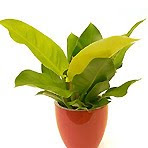bamboo palm
When we moved into our house a few years ago, I didn't realize how toxic the combination of new materials would be to my family's health. My allergies went crazy and I started suffering from chronic migraines and fatigue. Our baby, Jack, then 8 months old suffered from chronic allergies and bronchial infections. I didn't realize it was from the new carpet and glue in the recently installed cabinets until a pediatrician asked if we'd moved into a new home recently and informed me of the toxins.
Of course I wanted to rip out the carpets, but that wasn't budget friendly. I felt so guilty and desperate I went out and bought expensive air purifiers and threw myself into research on the subject. I want to share the harm of indoor toxins, not so you too will panic, but be aware of the dangers and do what ever you can to clean out your home. Plants are a wonderful fix. They are pretty and clean your air. Check here for a list of the top ten plants to clean your indoor air.
When we moved into our house a few years ago, I didn't realize how toxic the combination of new materials would be to my family's health. My allergies went crazy and I started suffering from chronic migraines and fatigue. Our baby, Jack, then 8 months old suffered from chronic allergies and bronchial infections. I didn't realize it was from the new carpet and glue in the recently installed cabinets until a pediatrician asked if we'd moved into a new home recently and informed me of the toxins.
Of course I wanted to rip out the carpets, but that wasn't budget friendly. I felt so guilty and desperate I went out and bought expensive air purifiers and threw myself into research on the subject. I want to share the harm of indoor toxins, not so you too will panic, but be aware of the dangers and do what ever you can to clean out your home. Plants are a wonderful fix. They are pretty and clean your air. Check here for a list of the top ten plants to clean your indoor air.
I never considered that E. Coli could be tracked into my home after using a public restroom hours earlier. I also never thought that ordinary dirt was harmful, but I came to discover that dirt can contain alarming levels of lead. The Door Mat Study concludes that using a door mat cuts down the toxic lead dust levels in a home virtually in half and taking off your shoes before entering your home cuts the toxic dust down by 60%. So by implementing both rules, you can cut down the toxic dust being tracked into your home by 98.5%, and considering that 2% of the dust in our homes is from inside sources while the remaining 98% is the result of wearing shoes indoors, we can almost eliminate the indoor dust completely.
Recently, the Environmental Protection Agency has shown that indoor air may be even more polluted than the air outside. You may be asking yourself, "How can this be?" Many of us envision our homes as our private, safe sanctuaries. This is due, in large part, to the high amount of toxic chemicals in the products we use, as well as our bad habits
Dracaena
Household products, furnishings and cosmetics release vapors and particles that people can inhale or absorb through the skin. Then there are the pollutants that are tracked into the house from outside that add to the hazard.
The nation's best researchers on indoor air pollution are cautioning consumers that levels in houses are many times higher than those from the outdoors, even when compared to city air where trucks and factories belch pollution.
Common indoor plants may provide a valuable weapon in the fight against rising levels of indoor air pollution. NASA scientists are finding them to be surprisingly useful in absorbing potentially harmful gases and cleaning the air inside homes, indoor public spaces and office buildings.
The indoor pollutants that affect health are formaldehyde, Volatile Organic Compounds (benzene and trichloroethylene or TCE), airborne biological pollutants, carbon monoxide and nitrogen oxides, pesticides and disinfectants (phenols), and radon. These pollutants contribute to ’sick building syndrome’, which causes symptoms ranging from allergies, headaches and fatigue through to nervous-system disorders, cancer and death.










No comments:
Post a Comment